Solar eclipse of May 28, 1900
A total solar eclipse occurred on May 28, 1900. A solar eclipse occurs when the Moon passes between Earth and the Sun, thereby totally or partly obscuring the image of the Sun for a viewer on Earth. A total solar eclipse occurs when the Moon's apparent diameter is larger than the Sun's, blocking all direct sunlight, turning day into darkness. Totality occurs in a narrow path across Earth's surface, with the partial solar eclipse visible over a surrounding region thousands of kilometres wide.
| Solar eclipse of May 28, 1900 | |
|---|---|
.jpg.webp) Totality photographed in Wadesboro, North Carolina, by Thomas Smillie for the Smithsonian Solar Eclipse Expedition to capture photographic proof of the solar corona | |
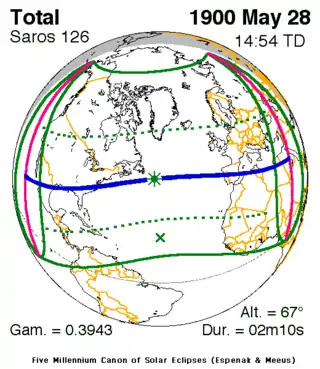 Map | |
| Type of eclipse | |
| Nature | Total |
| Gamma | 0.3943 |
| Magnitude | 1.0249 |
| Maximum eclipse | |
| Duration | 130 sec (2 m 10 s) |
| Coordinates | 44.8°N 46.5°W |
| Max. width of band | 92 km (57 mi) |
| Times (UTC) | |
| Greatest eclipse | 14:53:56 |
| References | |
| Saros | 126 (41 of 72) |
| Catalog # (SE5000) | 9281 |
Viewing
In 1900 the Smithsonian Astrophysical Observatory, then based in Washington, D.C., loaded several railroad cars with scientific equipment and headed to Wadesboro, North Carolina. Scientists had determined that this small town would be the best location in North America for viewing an expected total solar eclipse, and the Smithsonian Solar Eclipse Expedition hoped to capture photographic proof of the solar corona during the event for further study.[1] The team included Smithsonian photographer Thomas Smillie, who headed up the missions photographic component. Smillie rigged cameras to seven telescopes and successfully made eight glass-plate negatives, ranging in size from eleven by fourteen inches to thirty by thirty inches. At the time, Smillie's work was considered an amazing photographic and scientific achievement.[2]
In addition to the team from the Smithsonian:
[s]cientific expeditions were mounted from some of the world’s preeminent astronomy programs including Princeton University, the University of Chicago, . . . and the British Astronomical Association. S. P. Langley and C. A. Young, two of the founders of modern astronomy, were also there.
According to the Anson Independent, a local newspaper, the public came out in droves. Extra trains—including a special excursion train from Charlotte—brought out hundreds of people, and by the time the eclipse’s effects were beginning to be seen around 7:30 a.m., the streets were packed and people were vying for better spots on top of and out of the windows of buildings.
The same local newspaper described the total eclipse itself as lasting for less than a minute and a half, and recorded that though a large crowd was on hand it was nearly silent during that entire time. The paper also mentioned that the drop in temperature from the shadow caused by the eclipse was quite significant.[1]
The eclipse was filmed by Nevil Maskelyne in North Carolina.[3]
 A map from 1900 |
 The stars during total eclipse |
Related eclipses
Solar eclipses of 1898–1902
This eclipse is a member of the 1898–1902 solar eclipse semester series. An eclipse in a semester series of solar eclipses repeats approximately every 177 days and 4 hours (a semester) at alternating nodes of the Moon's orbit.
| Solar eclipse series sets from 1898–1902 | ||||
|---|---|---|---|---|
| Ascending node | Descending node | |||
| 111 | December 13, 1898 Partial |
116 | June 8, 1899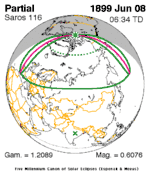 Partial | |
| 121 | December 3, 1899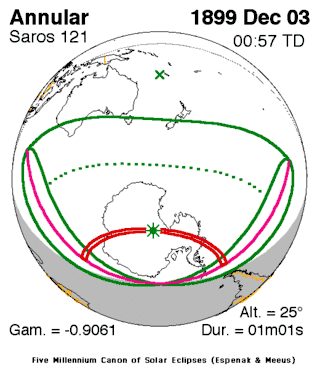 Annular |
126 | May 28, 1900 Total | |
| 131 | November 22, 1900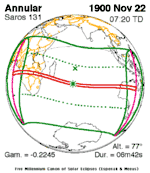 Annular |
136 | May 18, 1901 Total | |
| 141 | November 11, 1901 Annular |
146 | May 7, 1902 Partial | |
| 151 | October 31, 1902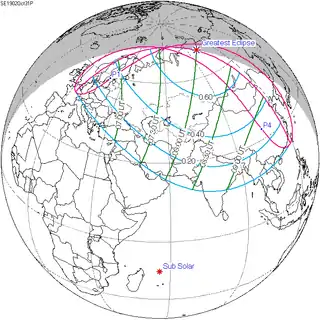 Partial | |||
Saros 126
It is a part of Saros cycle 126, repeating every 18 years, 11 days, containing 72 events. The series started with partial solar eclipse on March 10, 1179. It contains annular eclipses from June 4, 1323 through April 4, 1810, hybrid eclipses from April 14, 1828 through May 6, 1864 and total eclipses from May 17, 1882 through August 23, 2044. The series ends at member 72 as a partial eclipse on May 3, 2459. The longest duration of central eclipse (annular or total) was 6 minutes, 30 seconds of annularity on June 26, 1359. The longest duration of totality was 2 minutes, 36 seconds on July 10, 1972. All eclipses in this series occurs at the Moon’s descending node.
| Series members 42–52 occur between 1901 and 2100 | ||
|---|---|---|
| 42 | 43 | 44 |
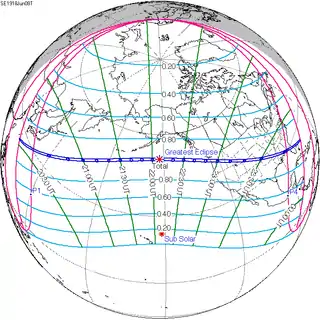 June 8, 1918 |
 June 19, 1936 |
 June 30, 1954 |
| 45 | 46 | 47 |
 July 10, 1972 |
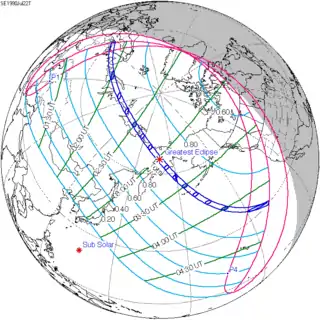 July 22, 1990 |
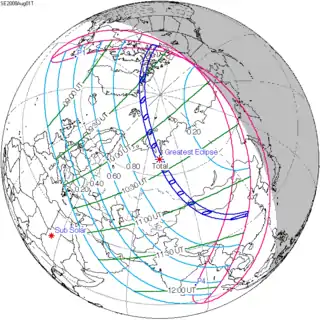 August 1, 2008 |
| 48 | 49 | 50 |
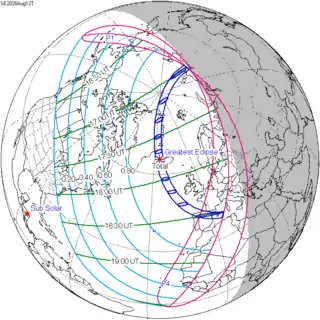 August 12, 2026 |
 August 23, 2044 |
 September 3, 2062 |
| 51 | 52 | |
 September 13, 2080 |
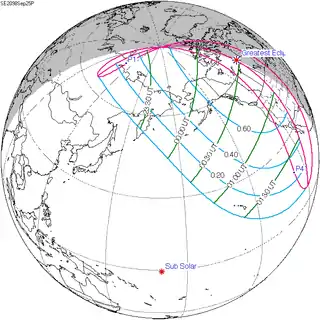 September 25, 2098 | |
Notes
- "Wadesboro Prime for Viewing of 1900 Solar Eclipse". This Day in North Carolina History. N.C. Department of Natural & Cultural Resources. Retrieved 28 May 2019.
- Foresta, Merry. "Smillie and the 1900 Eclipse". Smithsonian Institution Archives.
- "‘Captivating’ – BFI shares first footage of a solar eclipse from 1900" (retrieved 30 May 2019)
References
- NASA graphic
- Photos and sketches of the Solar Corona May 28, 1900
- The Total Solar Eclipse, 1900 Report of the expeditions organized by the British Astronomical Association to observe the total solar eclipse of 1900, May 28, A Publication of the British Astronomical Association, Chapter VII: "Elche" (Spain), by Mr. E. W. Johnson
- Total Eclipses of the Sun, By Mabel Loomis Todd, 1894, new and revised edition by David Peck Todd, 1900.
- Lewis E. Jewell et al. "Reports concerning the total solar eclipse of May 28, 1900 and of May 17, 1901”, Publications of the U.S. Naval Observatory 4 (1906) app. 1, 94–97, 121–151, 203–215, 299–307 and pl. LXXII.
- Russia expedition for solar eclipse of May 28, 1900
- "Print from Glass Plate Negative of eclipse, Wilkes County, Georgia, 1900 May 28". Vanishing Georgia, Georgia Archives. Digital Library of Georgia. Retrieved 5 April 2018.
| Wikimedia Commons has media related to Solar eclipse of 1900 May 28. |
.jpg.webp)

